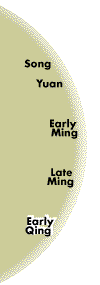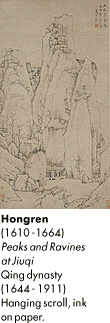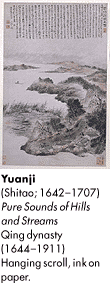 |
 |
 |
 |
 |
 |
 |

Beginning in the early Qing dynasty, southern Anhui was
dominated by a school of painters who took the splendor of
the local Mount Huang as their principal subject. The style
of the Xin'an school, as they came to be called, grew out
of the stark and linear manner inspired by Ni Zan and Dong
Qichang, combined with an emphasis on semiabstract forms
well suited to render the rectilinear, flinty rock surfaces
of the nearby mountains. The central and perhaps most
original figure in this group was Hongren. Peaks and
Ravines at Jiuqi, less severe and geometricized than
his other works, is a monumental landscape despite the
artist's self-imposed limitations. The sparse trees growing
from the rocky crevices and the path leading up to a simple
pavilion invite imaginary engagement with a gaunt and
barren natural world. |
 |
 |
 |
 |
The best works of the
Individualists engage the viewer in visionary worlds of
overwhelming power and presence. Whereas the Orthodox
masters explored a canonical past of styles on which they
could comment knowingly, the Individualists sought
pictorial devices that would enhance the visual impact of
their images. With Gong Xian, the key figure in the Nanjing
school of painters in the early Qing, the search extended
to the European pictorial tradition seen in paintings and
prints brought to China by Jesuit missionaries. In
Summer Mountains after Rain the use of light
and shade, as well as air and space, cannot be accounted
for by Chinese precedents alone. The indistinct and
overlapping brushstrokes on the slopes resemble a
Western-style stippling effect, and the strange and
ambiguous areas of light, setting off the tree groves, seem
equally foreign in Chinese landscapes. But Gong used
European illusionistic devices not to portray a rational
environment but to create somber and unsettling
otherworldly visions. Gong lived through the throes of
dynastic change, and this landscape, which is at once
airless, menacing, and claustrophobic, can be read in terms
of anti-Manchu sentiment and loyalty to the fallen Ming
regime. |
 |
 |
 |
 |
As a descendant of Ming
royalty living under Manchu rule, Bada Shanren was a
yimin, a subject left over from the fallen dynasty.
Probably to deflect any suspicion of political intentions,
Bada became a Buddhist monk. His symptoms of extreme
madness may have been feigned for further protection, or
may be evidence of genuine derangement. The enigmatic
nature and pronounced originality of paintings such as
this, which he completed at the age of seventy-one, are
appropriate visual analogues to his bizarre behavior. In
this painting, which depicts two ducks engaged in a fierce
staring contest, Bada manipulates his subject to achieve
intense personal expression through unexpected
juxtapositions in composition, brushwork, and inkwash.
Unlike the other Individualists, Bada did not often paint
landscapes but rather concentrated on the depiction of
birds and fish that expressed intense, enigmatic human
emotions. He places them amid rocks and plants that are
distorted, disproportionate in size, and seemingly
unanchored in space. Here the off-balance poses and cryptic
interaction between the two ducks, the rock hovering in
space, and the way the contours of rock and lotus stalks
repeat and intersect as they twist upward, confusing mass
and space, give vivid expression to Bada's "madness" and to
his sense of a world out of joint. |
 |
 |
 |
 |
Yuanji, like Bada Shanren,
was a descendant of the Ming royal house and also sought
refuge from political trouble in the Buddhist church.
Because he was much younger, the fall of the Ming was less
traumatic for him, and he accommodated to Manchu rule. In
sharp contrast to Dong Qichang and his followers, Yuanji
renounced the use of ancient styles as prototypes and
advocated a radical originality, a "method that is no
method." Pure Sounds of Hills and
Streams brings these concerns to the fore. The
surface is enlivened through the heavy application of dots
that seem to vibrate away from the solid masses, conveying
a state more psychological than physical. The work was
probably painted during his years in Nanjing, 1680-1687,
when he came into contact with the work of Gong Xian, whose
paintings from the 1680s feature a dotting technique
similar to that of Yuanji. |
 |




